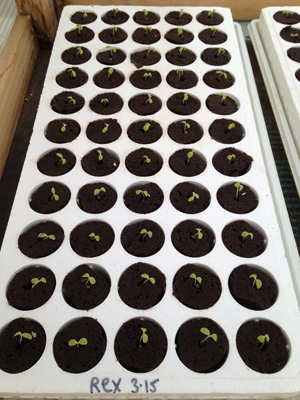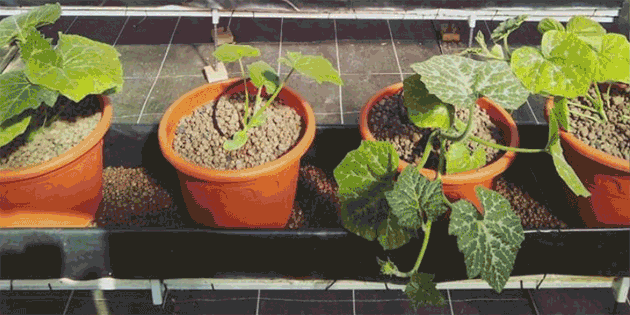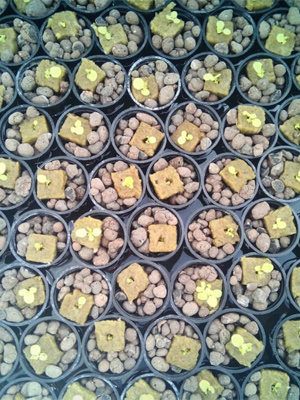- Introduction to Hydroponic Growing | Article | Johnny's Selected Seeds
- Introductory Hydroponics Information Guide | Printable 4-pp Brochure (PDF)
- Hydroponics Variety Listing | Printable 2-pp Brochure Insert (PDF)
- Hydroponic Varieties | Printable 2-pp Line Sheet (PDF)
- How to Grow Healthy Hydroponic Seedlings | Seed-Starting & Environmental Variables
- Hydroponic Seed-Starting & Environmental Variables | Tech Sheet (PDF)
- Hydroponic Grow Media | 10 Common Types, Care & Additional Considerations
- Hydroponic Growing Media | Tech Sheet (PDF)
- Pest & Disease Control Basics in Greenhouse, Hydroponic & Other Protected-Culture Systems
- Pests & Diseases of Greenhouses & Hydroponic Systems | Tech Sheet (PDF)
- Hydroponic & Container Basil Guide | Production Advice & Variety Recommendations
- Hydroponic & Container Basil Guide | Printable 4-pp Brochure (PDF)
- Digital Hydroponic Head Lettuce Catalog | Johnny’s Selected Seeds
Choosing Your Hydroponic Grow Medium • A Review of 10 Common Types
• Selecting a Medium • Using Plugs vs. Soilless Media • Monitoring Salt Build-up • Grow Medium Hygiene
ON THIS PAGE
- Choosing Your Hydroponic Medium
- Plugs vs. Soilless Mix in Hydroponics
- Common Types of Hydroponic Media
- Coco coir
- Expanded clay pellets
- Gravel
- Hemp fiber
- Perlite
- Phenolic foam
- Rockwool
- Sand
- Sawdust
- Soilless mix
- Comparison Chart of 10 Hydroponic Media Types
- Salt Buildup in Hydroponic Media
- Sterilizing Your Hydroponic Media & Cleaning Your System
- LEARN MORE
We do not currently conduct hydroponic trials at Johnny's research farm, but have compiled this information in consultation with our hydroponic trial cooperators, academic and industry resources, and independent hydroponic growers.
Nagualma Hydroponic Farm, Cannes, FRANCE
On the Grow Farms, Allen, Texas
Paul Gallione, Johnny's Territory Sales Rep (Retired); Owner, Moosehead Trail Farm, Waldo, Maine
Used with permission. All rights reserved.
Options, Care & Maintenance Considerations
In place of soil, hydroponic growers around the world use a variety of grow media to provide a substrate that anchors the plants and assists in delivering water, nutrients, and oxygen to the plant roots. Here is a comparison of some of the most common growing medium options, with additional information on maintenance considerations such as sterilization and flushing, to help you choose a suitable medium for your hydroponic operation.
Choosing Your Hydroponic Medium
The medium you choose will depend upon the design, scale, and location of your hydroponic system, as well as the crops you grow. Here are some features to check for in your growing media, as you ponder your options:
- Is it easy to handle and pot-up?
- Is it affordable and available in your region?
- If used for seed-starting, does it provide good seed-to-medium contact?
- Does it afford growing plants some physical stability?
- If temperature swings are a concern, does it provide a measure of thermal insulation to the roots?
- Is it free of toxins, contaminants, and pathogens that could inhibit germination, stunt growth, or introduce disease?
- What is its cation exchange capacity (CEC)? This is the ability of a growing medium to retain and release positively-charged elements (cations) from the nutrient solution, while not upsetting the balance of the nutrient solution. Most fertilizer micronutrients, as well as a few macronutrients, have a positive charge of +1 or +2.
- What is its water holding capacity (WHC)? If you rely on your system to hold water between irrigation cycles, look for a medium with high water retention.
- Inversely to the above, what is its air-filled porosity (AFP)? This is the extent of voids (air space) in the grow medium at any point of time that are not filled with water. The medium should be able to maintain good aeration to plant roots, or, at minimum, have no negative bearing on aeration.
- Do you plan to grow using integrated pest management (IPM) and/or organically? If so, look for an organic medium, such as coco coir, that can be inoculated with beneficial microbes.
- What is the material's reusability and recyclability?
All of these characteristics are important to your success. Before you scale up, plan to experiment with different media to find the best solution for your growing needs. Different crops may thrive best within different systems, conditions, and media configurations.
Plugs vs. Soilless Mix in Hydroponics
Some hydroponic media come in bulk, loose form that you can use to fill trays, bags, or buckets. Other media come in the form of discrete plugs, blocks, discs, or slabs.
The key advantage of using plugs is that you can seed directly into small-sized propagation plugs marked with dibbles that hold each seed, and as the plants develop, bump them up into larger growing blocks, without moving them from the propagation plugs. Potting seedlings up in this fashion helps to prevent or minimize transplant shock. Many commercial hydroponic growers start plants in plugs, pot-up the starts into larger blocks, then pot-up a third time into the final medium, which could be pots, trays, slabs, bags, or buckets filled with a soilless mix.
10 Different Types of Hydroponic Media
Of the many options for hydroponic media, these are some of the most common.
COCO COIR
Made from the outer husk of coconuts, coco coir is a byproduct of the coconut industry. It is usually sold as plugs, blocks, or slabs. It is highly absorptive and retains water well between irrigation cycles while also providing good root aeration. It has natural antifungal properties and can be inoculated with beneficial microbes. The physical properties should last for several years of use before needing to be replaced, as long as disease infestation is managed. Depending upon production techniques, coir may contain high salt levels at the time of purchase; it is therefore important to buy coir that is labeled as having low EC (electroconductivity) or low salt levels. If high EC is a concern, it is recommended to reduce the initial coir EC by leaching the medium with water before planting. Coir is not inert; it contains potassium. As a result, you may want to use a coir-specific nutrient solution formulated to provide nutrients at a ratio appropriate for growing in coir. Unlike rockwool, coir is biodegradable and renewable.
EXPANDED CLAY PELLETS or PEBBLES
Also called grow rocks, expanded clay pellets are available in sizes ranging from 1–18mm in diameter. They contain tiny air pockets that provide for good drainage and root aeration, but do not retain water well and thus require frequent irrigation. Clay pellets last for many crop cycles before they begin to break down, but diseases must be managed if the pellets are reused. They are bulky, however, and nutrients may precipitate out of the solution and coat the pellet surface, requiring washing before reuse. To cut down on clay particulates that can clog filters and drippers, thoroughly rinse clay pellets before using them.
GRAVEL
Gravel is inexpensive, readily obtainable, easy to clean, and drains well. Because of its weight and inability to absorb water, however, it is not a commonly used medium. It can be useful when other media are unavailable, is isolated locales, or for limited applications. It is not suited for use in systems that rely on the medium to keep the plant roots moist, such as ebb-and-flow systems, but can be used in drip or flood systems. The gravel used should be noncalcareous (avoid limestone) and chemically inert. Your system materials and methods must be able to accommodate the considerable weight associated with this medium.
HEMP FIBER
Grow mats made from decorticated and cleaned industrial hemp fibers are a pH-neutral (6.7), 100% biodegradable and compostable option. Hemp's high water-holding capacity provides a moist environment favorable to germination and supports strong root growth, making it an especially well-suited substrate for hydroponic microgreens production.
PERLITE
A volcanic rock mined from lava flows, horticultural grades of perlite are available in fine grades suitable for starting seeds, coarse grades suitable for propagation, or mixes of sizes for crop production. It can be used on its own or as part of a soilless mix. It is extremely lightweight, has good wicking, is highly absorptive, and provides good root aeration, making it very well suited to wick systems. It does not retain water well, however, and can dry out quickly between irrigation cycles. It has no cation exchange capacity, so it provides no buffering. Because it floats in water it may not be ideal for ebb-and-flow systems. Be sure to use eye protection and a dust mask when handling dry perlite. It is safer to pre-wet the perlite before handling the product.
PHENOLIC FOAM

Also known as floral foam or peat foam, phenolic foam is a synthetic product available as plugs and commonly used for starting seeds. It is designed to offer an optimal water absorption/retention to root aeration ratio. It is generally reusable for more than one growing season; be sure to check the manufacturer's documentation for the expected lifespan of specific brand name foams, as well as requesting specifics on compostability/biodegradability. Some are biodegradable in about 18–24 months.
ROCKWOOL
Rockwool is made from volcanic rock, limestone, and coke, melted together at high temperature. The molten rock is then spun into cotton-candy like fibers, cooled, and woven into plugs, blocks, or slabs. It is a sterile medium, and one of the most commonly used hydroponic substrates worldwide, providing good water retention and root aeration. With thorough rinsing and no disease issues, it can be reused, and should last for several years before needing to be replaced. Rockwool is nonbiodegradable, so the user needs to arrange for proper disposal. Rockwool products can have a high pH from bonding agents used to shape the material. For best results, presoak rockwool in a slightly acidic solution (pH 5.5) before use and make a practice of monitoring system pH closely. This fibrous material is highly irritating to the skin, eyes, and lungs, and wearing a dust mask, goggles, and gloves whenever handling rockwool is strongly recommended.
SAND
Sand is inexpensive and easy to source. Sand of adequately large particle size can provide good water retention and root aeration; the ideal sand particle size is at least 2mm in diameter. If water drains freely and doesn't puddle, then your sand is probably of the right size. Sometimes perlite is added to sand for increased aeration. Avoid limestone sand, as it will raise the pH of your nutrient solution. Also note that wet sand is very heavy; plan your system accordingly.
SAWDUST
Sawdust can have excellent water absorption and retention. Choose sawdust with a moderate particle size; moisture spreads more easily through fine sawdust than coarse sawdust, but if the particles are too fine it can limit root aeration. Avoid chemically treated source material and avoid Western red cedar, which is toxic to plants. Source wood can sometimes become contaminated with salt during transport of logs to the mill; be sure to test initial salt levels with an electroconductivity (EC) meter and if salt levels exceed 10ppm, flush thoroughly with fresh water before use. Sawdust breaks down quickly, and at least a portion of the media will need to be replaced between each crop cycle.
SOILLESS MIXTURES
There are many kinds of soilless mixtures available. Commonly used components include vermiculite (a micaceous volcanic mineral), peat moss, pine bark, sand, and/or perlite. The well-known Peat-Lite mixtures developed at Cornell University, for example, are a 50-50 mix of peat and vermiculite (Mix A); a 50-50 mix of peat and perlite (Mix B); and a 50-25-25 mix of peat, vermiculite, and perlite (Mix C). Soilless mixtures tend to break down during the growing period, eventually resulting in compaction, and therefore need to be replaced periodically. The environmental impact of draining peat bogs for peat moss extraction is also a concern with mixtures containing peat.
COMPARISON CHART OF 9 HYDROPONIC MEDIA TYPES |
|||||
| Medium | Available in blocks | Biodegradable | Sterile at purchase | Lifespan * | Notes |
| Coco coir | Many crop cycles | Look for a product with a low EC, or low salt content. | |||
| Expanded clay pellets | Many crop cycles | ||||
| Gravel | Indefinite | Avoid limestone, which can raise solution pH. | |||
| Hemp fiber | Single crop cycle | 100% biodegradable and compostable. | |||
| Perlite | Many crop cycles | ||||
| Phenolic foam | Some, but not most types; check with manufacturer | Varies; check with manufacturer | Mainly used for starting transplants. | ||
| Rockwool | Many crop cycles | May require soaking to reduce pH prior to use. | |||
| Sand | Indefinite | Avoid limestone, which can raise solution pH. | |||
| Sawdust | Needs replenishing between crop cycles | Avoid chemically treated or tainted source material; avoid Western red cedar. | |||
| Soilless mix | Varies | Needs replenishing between crop cycles | May include peat, perlite, pine bark, vermiculite, limestone, sand, or other nonsoil material. | ||
| * Estimated usable lifespan, assuming grower has the capacity to sterilize media between crop cycles as needed. | |||||
Salt Buildup in Hydroponic Media
Plants do not usually take in all the nutrients dissolved in growing solutions; as a result, salts can build up in the growing medium over time. It is important to limit salt buildup because it can raise pH, upset water and nutrient uptake by the plants, and ultimately harm plant health. Using excessive or higher than necessary EC can contribute to salt buildup.
To reduce salt buildup, flush the medium and the container/tray with clear water, using about twice as much water as the volume of the container, and allow the leachate to run freely out of the container. The amount of water needed will vary by medium; more porous media, such as perlite, clay pellets, and sand will be easier to flush than other media types.
Some experts recommend flushing weekly, others monthly. For the home gardener, flushing every 30 days is likely to be adequate. You should also flush the medium if your plants are showing signs of toxic nutrient buildup. If a clear water flush does not help, you can try a store-bought flushing product that contains chemical chelating agents.
Sterilizing Your Hydroponic Medium & Cleaning Your System
Cleaning your entire system on a routine basis serves to reduce nutrient residue buildup on trays and equipment, eliminate pathogens, and remove debris such as plant matter and particles that result from media breakdown that can clog your system pumps and filters.
How frequently you clean your system depends upon the type of system, your crops, and the disease pressures you encounter. Many commercial growers employ steam or chemical sterilization methods, whereas smaller growers and home gardeners opt for one or more of the following methods:
- Oven pasteurization: Bake at 180°F (82°C) for 30 minutes (vermiculite, perlite, clay, or sand).
- Solarization: Moisten medium, cover with clear plastic, and leave to steam in the sun. To be fully effective, solarization typically will require being covered at least 6 weeks during the high temperature time of year.
- Bleach: Soak medium in a 10% bleach solution for 20 minutes; follow with multiple water rinses.
Learn More
The key advantage to using a hydroponic grow medium is that it gives the grower a wider margin for error. The medium can provide the plants a measure of protection from drying out as well as delivering moisture and nutrients, and can act as a buffer should a pump or other sensitive component of the system fail.
Johnny's Hydroponic Growing Resources
- Downloadable, printable version of this article Tech Sheet (PDF)
- Introduction to Hydroponic Growing • Types of Systems; How Hydroponics Differs from Growing in Soil; Scheduling Plantings; Specialty Techniques; How to Choose Varieties for Hydroponic Production Article
- Hydroponic Seed-Starting & Environmental Variables • How to Begin, What to Monitor & Why Article
- Hydroponics Information Guide 4-pp Brochure (PDF)
- Hydroponic Performers Variety Listing 2-pp Insert Sheet (PDF)
- Pests & Diseases of Greenhouses & Hydroponic Systems Tech Sheet (PDF)
General Hydroponic Growing Resources
- Hydroponic Society of America.
- Hydroponics. University of Florida: IFAS Extension.
- Cornell Controlled Environmental Agriculture.
References
- Boodley, J. & R. Sheldrake. 1982. Cornell Peat-Lite Mixes for Commercial Plant Growing. Cornell Cooperative Extension Information Bulletin 43.
- DeBoer, B. 2015. Electrical Conductivity and Monitoring Plant Nutrition. Maximum Yield.
- Helweg, R. 2014. How to Grow Fruits, Vegetables & Houseplants Without Soil. Ocala, FL: Atlantic Publishing Group, Inc.
- Hopper, E. 2015. Dissolved Oxygen: The Hidden Necessity. Maximum Yield.
- How to Grow Hydroponics: Temperature & Humidity. Hydroponics — Simplified.
- Jones, B.J. 2016. Hydroponics: A Practical Guide for the Soilless Grower. CRC Press.
- Leonhardt, K.W. & W.W. McCall. 1982. Hydroponics. HI Cooperative Extension Service.
- Mansfield, M. 2016. The Power of pH. Maximum Yield.
- Morgan, L. 2014. The How-To of Organic Hydroponics. Maximum Yield.
- McSorley, R. & H.K. Gill. 2019. Introduction to Soil Solarization. FL EDIS IFAS Extension.
- Peterson, D. 2018. Techniques, varieties fuel success with hydroponic strawberries. Vegetable Growers News.
- pH/TDS/PPM Levels for Vegetables. Home Hydro Systems.
- Resh, H.M. 2013. Hydroponic Food Production: A Definitive Guidebook for the Advanced Home Gardener and the Commercial Hydroponic Grower. 7th ed. New York: CRC Press.
- Resh, H.M. 1993. Hydroponic Tomatoes for the Home Gardener. Santa Barbara: Woodbridge Press Publishing Company.
- Rorabaugh, P.A. 2015. Introduction to Hydroponics and Controlled Environment Agriculture. UACEAC.
- Stewart, K. 1992. Hydroponics for the Home Gardener. Ontario: Key Porter Books.
- White, B. 2004. Alternative hydroponic substrates. Greenhouse Product News.



